|
|
|
Sort Order |
|
|
|
Items / Page
|
|
|
|
|
|
|
| Srl | Item |
| 1 |
ID:
107659
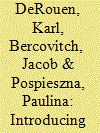

|
|
|
|
|
| Publication |
2011.
|
| Summary/Abstract |
Mediation is one of the few mechanisms the international community can deploy that will affect civil wars. This article introduces the dataset on mediation in civil wars - termed the Civil War Mediation (CWM) dataset. This is the first dataset to focus solely on civil war mediation. These data contribute to the present state of quantitative research on mediation in three important respects: the data are collected for the period of 1946-2004, are organized by mediation cases and by civil war episode, and provide detailed information about mediation incidences. The article first presents a few variables included in the dataset that are motivated by theoretical arguments from the literature. After a presentation of summary statistics, attention is turned to using the CWM data to explore the determinants of mediation. Mediation is shown to be a function of war type (territorial and internationalized wars are more likely to be mediated), war duration (the longer the war the higher the probability of mediation), supply-side factors (the number of democracies in the world and the global polity average), and stratum (subsequent wars are less likely to be mediated). Battle-related deaths also seem to increase the chances of mediation, though the relationship is only weakly significant. The article concludes with suggestions for future research that can benefit from the dataset.
|
|
|
|
|
|
|
|
|
|
|
|
|
|
|
|
| 2 |
ID:
107653
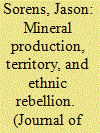

|
|
|
|
|
| Publication |
2011.
|
| Summary/Abstract |
Several possible relationships between natural resources and civil conflict have been hypothesized and tested in the literature. The impact of resources on conflict should depend on the circumstances of the group that (potential) rebels see themselves as representing and depend upon for support. While 'lootable' resources such as alluvial diamonds have been shown to increase the likelihood of insurgency, among territorially concentrated ethnic groups looting by rebels recruiting from the group is counterproductive because it imposes negative externalities on the rebel constituency. However, local mineral abundance could encourage rebellion indirectly, by promoting the development of secessionist objectives, since autonomy or independence would allow the rebel constituency to enjoy a larger share of the benefits flowing from mineral revenues. On the other hand, mineral abundance could encourage the government to exercise greater surveillance and control over potentially restive minority populations. On balance, then, mineral abundance should affect ethnoregional conflict primarily by encouraging ethnic rebels to adopt limited, territorial-autonomy objectives as opposed to governmental objectives. This hypothesis is tested with a new, global dataset of substate mineral production. Local mineral resource abundance is indeed negatively associated with governmental conflict among ethnoregional groups and positively related to secessionist or territorial conflict. Moreover, it is the total value of mineral production that matters, not specific types of minerals such as oil or diamonds. The net effect of mineral abundance on the total risk of intrastate conflict onset among ethnoregions is essentially zero.
|
|
|
|
|
|
|
|
|
|
|
|
|
|
|
|
| 3 |
ID:
107660
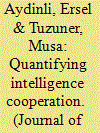

|
|
|
|
|
| Publication |
2011.
|
| Summary/Abstract |
This report describes the creation of the United States International Intelligence Behavior dataset (USIIB). The USIIB represents the first collection of event data specifically intended for exploring in a quantifiable manner the international intelligence cooperation behaviors of the United States. A total of 293,615 events are recorded in the USIIB, covering the years 2000-09. The report first provides a detailed description of the steps involved in building such a dataset, including the development of search terms, the use of a machine coding program (TABARI - Text Analysis by Augmenting Replacement Instructions) to extract data from wire news releases, and the extension of an existing coding scheme (CAMEO) to include intelligence behaviors. Following a discussion of issues related to the reliability and validity of event datasets in general and the USIIB in particular, the report then includes suggestions and examples for how the data in the current USIIB dataset may be used in order to add to our understandings of patterns and anomalies in international intelligence cooperation behavior. As a specific example, it offers results from an empirical test exploring variation in intelligence cooperation behaviors among democracies and non-democracies, asking specifically whether the United States has been more likely in the early 21st century to cooperate on intelligence matters with democratic states, and finding this not to have been the case. Finally, it aims to provide a guide for others who would like to extend this dataset to explore intelligence cooperation activity of other countries or regions.
|
|
|
|
|
|
|
|
|
|
|
|
|
|
|
|
| 4 |
ID:
107657
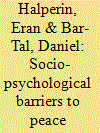

|
|
|
|
|
| Publication |
2011.
|
| Summary/Abstract |
Socio-psychological barriers play a major role in the continuation of intractable conflicts. They are responsible for the socio-psychological closure that resists and prevents the entertainment of alternative information that could potentially facilitate the acceptance of ideas advancing peacemaking processes. In an attempt to validate a process model that depicts the functioning of the socio-psychological barriers to conflict resolution, an empirical study was conducted among a nationwide representative sample of Jews in Israel, within the context of the Middle Eastern conflict. The reported study utilized a large scale survey, based on a nationwide representative sample of Israeli Jews who were asked to respond to a questionnaire which included the model's selected variables. As hypothesized, the results showed a path leading from general worldviews (e.g. General values, Right Wing Authoritarianism, Implicit theories about groups) to openness to new information and readiness to compromise through the mediation of the conflict-related societal beliefs (e.g. victimhood, delegitimization). These results indicate that closure to new information that may shed new light on both the rival and the conflict emerges as a crucial factor in the maintenance of society members' non-compromising views. The theoretical as well as the applied implications of the findings are discussed.
|
|
|
|
|
|
|
|
|
|
|
|
|
|
|
|
| 5 |
ID:
107658


|
|
|
|
|
| Publication |
2011.
|
| Summary/Abstract |
Scholars have long attempted to make distinctions among states based on regime type. Two of the most commonly used measures by both scholars and policymakers are the Freedom House Freedom in the World political rights and civil liberties measures. Despite their popularity, little is known about the measurement properties of these variables. In 2006, Freedom House began releasing the subcategory indicators used to generate the seven-point political rights and civil liberties scales as well as the freedom status indicator. I investigate the measurement properties of these scales using Bayesian measurement models (factor analysis and latent class analysis) that explicitly incorporate the goals of the Freedom House organization (which I argue are rigor, appropriate precision, and temporal stability). I find that (a) there is considerable variation hiding in the seven-point political rights and civil liberties classifications (e.g. many countries that are coded one by Freedom House are interestingly different from each other), (b) some countries coded in different categories by Freedom House are not interestingly different from each other (e.g. some twos are not different from some threes), and (c) the subindicators are all reliable indicators of political rights and civil liberties. I show that these differences can be substantively and statistically consequential when using the Freedom House data if the researcher's goals include comparison across space, comparison over time or predictive statistical modeling.
|
|
|
|
|
|
|
|
|
|
|
|
|
|
|
|
| 6 |
ID:
107656


|
|
|
|
|
| Publication |
2011.
|
| Summary/Abstract |
This article contributes to our understanding of transboundary environmental management regimes through the application of an analytical framework that facilitates an exploration of the co-existence of conflict and cooperation. Rather than framing conflict and cooperation as mutually exclusive states at opposite ends of a spectrum, we seek to understand the ways in which cooperation can exist at the same time as conflict. We apply this framework to a study of conservation management in a transboundary area at the intersection of the Democratic Republic of Congo, Rwanda and Uganda. We identify two actual and one hypothetical phase of conflict-cooperation relations, in a landscape notorious for some of the worst violence of the last two decades. We map the evolution of phases of transboundary protected area management against the evolving security context, and we find that this approach has greater explanatory power than previous approaches that polarize conflict and cooperation. In particular, it helps us to understand the drivers of environmental cooperation, including the evolving characteristics of that cooperation. This new way of understanding the relationship between environmental management and security also enables us to reconsider the potential for environmental management to be instrumental in working towards interstate security objectives, for example through peace parks. We don't find that the 'low politics' of environmental management should be seen as a predictable and manageable determinant of international relations. But an understanding of the coexistence of conflict and cooperation does also point to a more complex, non-linear relationship between low and high politics.
|
|
|
|
|
|
|
|
|
|
|
|
|
|
|
|
| 7 |
ID:
107654
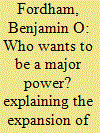

|
|
|
|
|
| Publication |
2011.
|
| Summary/Abstract |
Some states define their interests more broadly than others, looking beyond their immediate security and mobilizing their national wealth in pursuit of more ambitious goals. The most successful of these states come to be seen by others as major powers. Though major powers and states aspiring to attain this status are very important in world politics, relatively little explicit attention has been paid to the question of why some states expand their foreign policy ambitions, adopting what can be termed a major-power foreign policy. This article evaluates three explanations for this policy choice. Some international relations theory claims that potential power is itself a sufficient motivation for the adoption of major-power foreign policy. Other theorists suggest that some triggering condition is required, such as increasing international threat or expanding international economic interests. Evidence concerning the construction of military capabilities and diplomatic activism indicates that potential power alone does not offer a sufficient explanation for the adoption of major-power foreign policy. Both international threats and economic interests act as triggers for this choice, though they appear to push states toward different types of mobilization.
|
|
|
|
|
|
|
|
|
|
|
|
|
|
|
|
| 8 |
ID:
107655
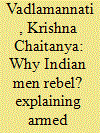

|
|
|
|
|
| Publication |
2011.
|
| Summary/Abstract |
Armed conflicts have been a permanent feature of the northeastern region since Indian independence. Surprisingly, relentless conflicts in this remote region of India have received little attention in the literature. Although some studies on conflicts in India have made important contributions to understanding and analyzing the causes of conflicts in general, none of them has paid specific attention to the ongoing conflicts in the northeastern region of India. Relative deprivation and persistent economic and political discrimination are often identified as the major causes for armed rebellion in this region. I provide a first quantitative test of this argument, exploring whether deprivation and continual economic and political discrimination explain the probability of armed conflict incidence across nine northeastern states of India during the period 1970-2007. The main findings from probit estimations show that poverty (relative to the rest of the country) and economic and political discrimination explain conflict outbreaks, after controlling for income, population pressures, state capacity, ethnic affiliations, forest area, peace years, neighboring conflict incidence, and distance to New Delhi. The study also reports considerable support for the baseline results when controlling for potential reverse feedback effects using the generalized method of moments. These results are robust to alternative estimation techniques and sample size.
|
|
|
|
|
|
|
|
|
|
|
|
|
|
|
|
|
|
|
|
|